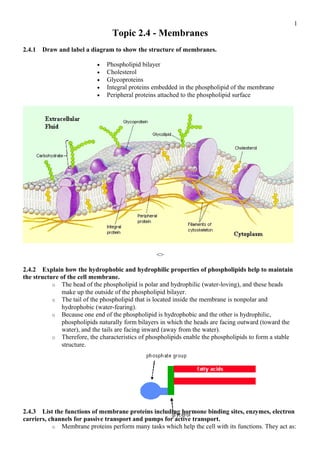
2.4 cell membranes notes
- 1. Topic 2.4 - Membranes 2.4.1 Draw and label a diagram to show the structure of membranes. • Phospholipid bilayer • Cholesterol • Glycoproteins • Integral proteins embedded in the phospholipid of the membrane • Peripheral proteins attached to the phospholipid surface <> 2.4.2 Explain how the hydrophobic and hydrophilic properties of phospholipids help to maintain the structure of the cell membrane. o The head of the phospholipid is polar and hydrophilic (water-loving), and these heads make up the outside of the phospholipid bilayer. o The tail of the phospholipid that is located inside the membrane is nonpolar and hydrophobic (water-fearing). o Because one end of the phospholipid is hydrophobic and the other is hydrophilic, phospholipids naturally form bilayers in which the heads are facing outward (toward the water), and the tails are facing inward (away from the water). o Therefore, the characteristics of phospholipids enable the phospholipids to form a stable structure. 2.4.3 List the functions of membrane proteins including hormone binding sites, enzymes, electron carriers, channels for passive transport and pumps for active transport. o Membrane proteins perform many tasks which help the cell with its functions. They act as: 1
- 2. o Hormone binding sites o Immobilized enzymes o Cell adhesion o Cell to cell communication o Channels for passive transport o Pumps for active transport. 2.4.4 Define diffusion and osmosis. o Diffusion is the passive movement of particles from a region of high concentration of that particle to a region of low concentration of that particle. The difference in concentration that drives diffusion is called a concentration gradient. o Osmosis is the passive movement of water molecules, across a partially permeable membrane, from a region of lower solute concentration to a region of higher solute concentration. 1.4.5 Explain passive transport across membranes in terms of diffusion. o Passive transport happens naturally (it requires no energy from the cell) if there is a concentration gradient between one side of the membrane and the other. This concentration gradient drives diffusion across the membrane. Concentration gradient: Molecules can diffuse across membranes from areas of higher to lower concentration by: • Simple diffusion: traveling directly through the membrane if they are small and uncharged, thus avoiding repulsion by the hydrophobic, non-polar tails of phospholipids in the middle of the membrane. • Facilitated diffusion: traveling through special transport proteins, if they match the shape and charge requirements to fit through the channels provided by the transport proteins. 2.4.6 Explain the role of protein pumps and ATP in active transport across membranes. o During active transport across membranes, the substance being transported goes against the gradient (it is going from where there is a lesser concentration to a greater concentration), and so energy is required to transport it in the form of ATP. Proton pumps 2
- 3. in the cell membrane function in transporting particles across a membrane against concentration membranes with energy from ATP. 2.4.7 Explain how vesicles are used to transport materials within a cell between the rough endoplasmic reticulum, Golgi apparatus and plasma membrane. • Vesicles are membranous sacs in which materials are stored and transported throughout the cell. • Protein synthesis: rER produces proteins which travel through the lumen of the ER • Transport in vesicles: transport vesicles travel to the Golgi, carrying the proteins within the vesicles • Modification: Golgi apparatus modifies proteins produced in rER • Transport to membrane: Golgi pinches off vesicles that contain modified proteins and travel to plasma membrane • Exocytosis: Vesicles then fuse with plasma membrane, releasing their contents by 3
- 4. 2.4.8 Describe how the fluidity of the membrane allows it to change shape, break and reform during endocytosis and exocytosis. o Endocytosis is the movement of material into a cell by a process in which the plasma membrane engulfs extracellular material, forming membrane-bound sacs that enter the cytoplasm. Exocytosis is the movement of material out of a cell by a process in which intracellular material is enclosed within a vesicle that moves to the plasma membrane and fuses with it, releasing the material outside the cell. o The cell membrane is fluid in that it is constantly in motion. The movement of the phospholipids changes the membrane's shape, and allows for temporary holes in the membrane that let materials flow in and out of the cell. If the membrane were not fluid in nature, it would not be able to fuse with vesicles in endocytosis and exocytosis. http://www.ibid.com.au/ibid/web.nsf/reslookup/203/$file/Endocytosis.swf 4